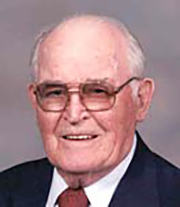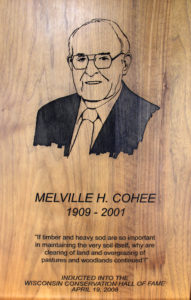1909 – 2001
Inducted 2008
“If timber and heavy sod are so important in maintaining the very soil itself, why are clearing of land and overgrazing of pastures and woodlands continued?” — Melville Cohee

Melville Cohee was among a handful of visionaries who established the soil conservation movement in America in the 1930s and who spearheaded the nation’s first erosion control pilot project at Coon Valley in Wisconsin.
Cohee joined other soil erosion pioneers, including Hall of Fame inductees and UW-Madison professors Aldo Leopold and George Wehrwein, in development of the Coon Valley Watershed Demonstration Project in southwest Wisconsin in 1933. The first of its kind in the nation, the project was chosen by the fledgling Soil Erosion Service under the leadership of Hugh Hammond Bennett. The Coon Valley project involved a 92,589-acre drainage basin in the hilly driftless region of southwestern Wisconsin, mostly in Vernon County.
The project proved to be a major success story in the effort to obtain watershed-scale erosion control. The strategy devised by the SES for demonstration work in the Coon Creek watershed was based on close personal contacts with cooperating farmers on their own land. This principle underlies private lands conservation work across America to this day. Federal and state programs delivered through local conservation districts with technical support from the Natural Resources Conservation Service, rely heavily on trust built with local landowners.
 Author Leonard C. Johnson summarized Cohee’s contributions and connections to other key conservation figures this way: “Under the direction of Professors George S. Wehrwein and Noble Clark (WCHF Inductee), Cohee analyzed the distribution of five categories of agricultural land use or cropping (woodland, cleared permanent pasture, hay, small grains, and corn) in relation to steepness of slope…”
Author Leonard C. Johnson summarized Cohee’s contributions and connections to other key conservation figures this way: “Under the direction of Professors George S. Wehrwein and Noble Clark (WCHF Inductee), Cohee analyzed the distribution of five categories of agricultural land use or cropping (woodland, cleared permanent pasture, hay, small grains, and corn) in relation to steepness of slope…”
Cohee’s work led him to ask this question: “If timber and heavy sod are so important in maintaining the very soil itself, why are clearing of land and overgrazing of pastures and woodlands continued?” The answer, he found, was in the economic demands faced by farmers and how that led them to treat the land. Commodity prices were driving land use decisions. That the situation continues to vex conservationists to this day doesn’t diminish the importance of Cohee’s work.
Cohee moved from the Coon Valley project to a lifetime of work in soil conservation, land use and agricultural economics. He was among the early leaders of the Soil and Water Conservation Society (SWCS). With a slim staff in the new organization, Cohee handled much of the organizations’ capacity-building and administrative work.
After a stint at a regional Soil Conservation Service (formerly SES) office in La Crosse, he was assigned to the Erosion Control Practices Division of the SCS in Washington, D.C. He traveled throughout the country to watershed demonstration projects, working to assure that erosion control practices and treatments for farms were coordinated and had economic quality and that farm conservation plans were properly made and applied.
From 1939-45, Cohee was chief of the Program Procedures and Project Plans Division of SCS. This put Cohee in charge of SCS project planning for the entire U.S. He also conducted research study in seven countries of Central Europe to determine how European governments had worked with local organizations and people to carry out natural resource conservation. Cohee continued his work with the SCS until retiring in 1965. He continued to do consulting work for Wisconsin’s Department of Natural Resources after his retirement.
Resources
Melville Cohee Obituary, 2001
Erosion and Land Utilization in the Driftless Area of Wisconsin by Melville Cohee
Wisconsin Conservation History – Soil Conservation Service & Natural Resources Conservation Service (see page 11)
The Leopold legacy for soil conservation, article by Melville Cohee for the Journal of Soil and Water Conservation
